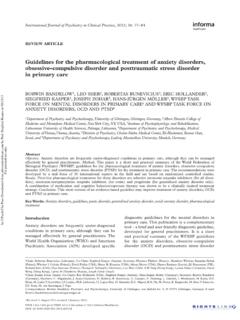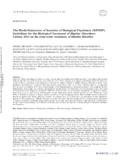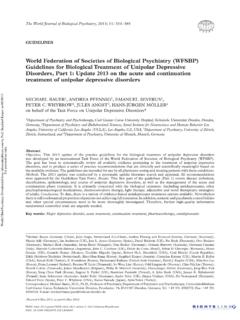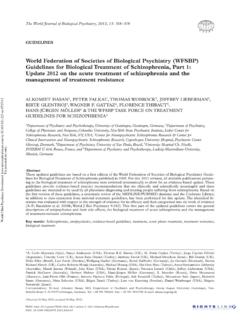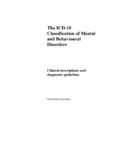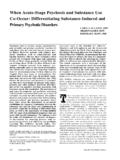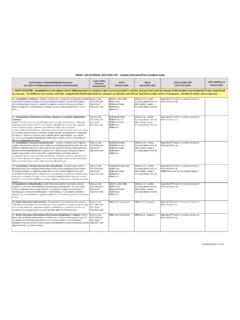Transcription of Prevention of homicidal behaviour in men with psychiatric ...
1 WFSBP CONSENSUS PAPER Prevention of homicidal behaviour in men with psychiatric disorders LEO SHER 1,2 & TIMOTHY RICE 1 ; ON BEHALF OF THE WORLD FEDERATION OF SOCIETIES OF BIOLOGICAL PSYCHIATRY (WFSBP) TASK FORCE ON MEN S MENTAL HEALTH * 1 Icahn School of Medicine at Mount Sinai, New York, USA, and 2 James J. Peters Veterans Administration Medical Center, New York, USA Abstract Objectives. Homicide is overwhelmingly committed by men compared to women. Conservative estimates suggest that more than a third of these individuals have a treatable psychiatric disorder.
2 These data present an opportunity to mental health clinicians to assist in the Prevention of homicide by improving men s mental health. Methods. We review the current lit-erature on men s mental health with a focus on assessing and reducing homicide risk in men with psychiatric conditions. Results. Bipolar disorder and schizophrenia appear to share a neural endophenotype that is a risk factor for homicide. Dual disorders , or the presence of a substance use disorder with other major mental illness, are a major risk factor for homicide in males. Dual diagnosis disorders , personality disorders and pathological traits and male depression share emotion dys-regulation, irritability, and reactive aggression.
3 Promoting physician education, addressing fi rearm safety, reducing the reluctance of men relative to women to engage in help-seeking behaviour , and using targeted risk interviews which integrate these data are all currently recommended. Conclusions. The main focus in Prevention of homicidal behaviour in males with psychiatric disorders should be to identify high risk groups, to provide adequate treatment, and to facilitate compliance with long-term treatment while considering male specifi c problems and needs. Key words: homicide; homicide suicide; men s mental health; endophenotypes; help-seeking behaviour Introduction Each year nearly half a million people worldwide, 437,000 in 2012, are murdered in violent crimes (Table I) (United Nations Offi ce of Drugs and Crime Research and Trend Analysis Branch 2013).
4 Almost all of the perpetrators of these violent crimes, about 90%, are men (United Nations Offi ce of Drugs and Crime Research and Trend Analysis Branch 2013; Oliffe et al. in press). Murder is a distinctly male problem. Many perpetrators of murder suffer from mental illness. Worldwide estimates range from 34% in the United Kingdom (Shaw et al. 2006) and 35% in Canada (Cote et al. 1992) to 53% in Sweden (Lindqvist 1986) and 58% in the United States (Martone et al. 2013); one study found as many as 90% had at least one psychiatric diagnosis (Fazel and Grann 2004). Many of these individuals are profoundly ill; studies have found that 20 23% of homicide defendants exhibited psychosis at the time of the incident (Gottlieb et al.)
5 1987; Fazel and Grann 2004). To signifi cantly reduce the numbers of murders worldwide, events which affect not only men but also women, families, and societies alike, Prevention pro-grams must incorporate these epidemiological data. It is the purpose of this communication to delineate the necessary determinants of an optimal approach to murder reduction among the mentally ill that is based on the available science. In the creation of this consensus paper, we began with a collection of articles gathered over the last * Chair: Leo Sher (USA); Co-Chair: Zoltan Rihmer (Hungary); Secretary: Timothy R. Rice (USA); Members: Mikkel Arendt (Denmark), M.
6 Dolores Braquehais (Spain), Javier Didia-Attas (Argentina), Masahito Fushimi (Japan), Julia Golier (USA), Jose de Leon (USA), Shih-Ku Lin (Taiwan), J. John Mann (USA), Anne-Maria M ller-Leimk hler (Germany), Alexander Neumeister (USA), Jorge Ospina-Duque (Colombia), Carlos Roncero (Spain), Wolfgang Rutz (Sweden), Robert G. Stern (USA), Nestor Szerman (Spain) . Correspondence: Leo Sher, MD, James J. Peters Veterans Administration Medical Center, 130 West Kingsbridge Road, Bronx, New York, NY 10468, USA. Tel: 1-718-584-9000 x 6821. Fax: 1-718-741-4703. E-mail: (Received 3 March 2015 ; accepted 3 March 2015 ) The World Journal of Biological Psychiatry, 2015; 16: 212 229 ISSN 1562-2975 print/ISSN 1814-1412 online 2015 Informa HealthcareDOI: J Biol Psychiatry Downloaded from by Prof.
7 Siegfried Kasper on 08/05/15 For personal use only. Consensus report: homicidal behaviour in men 213 Table I. Homicide rates per 100,000 people. , New Arab , , 2010 (World Bank, 2014). (Continued)Table I. (Continued )decade that were assessed to be of importance to the topic. Then, we complemented this collection with a search of the remaining literature through keywords including homicide, men s mental health, and specifi c psychiatric disorders . No specifi c exclu-sion criteria were used as we included reviews, stud-ies, opinion pieces, perspectives, and commentaries. Studies demonstrate that individuals with both mental illness and a co-occurring substance use dis-order are at the highest risk for violence and murder (Eronen et al.)
8 1996a, 1996b; Putkonen et al. 2004; Palijan et al. 2009b; Sher and Landers 2014). The program advocated in this proposal focuses on dual diagnosis patients as the target population for inter-vention. The data supporting the high risk status of this population is reviewed. Table II presents recent important studies on this topic in the academic lit-erature, which demonstrate that statistics concerning the relationship between homicide and psychiatric disorders vary widely, that there are signifi cant dif-ferences between regions and diagnostic methods, and that it is diffi cult to obtain accurate statistics. There are additionally important differences between types of murders, especially between sexual and non-sexual violence, and there is a signifi cant body of literature within each sub-type of violence ( , regarding sexual violence, Meloy 2000; Chan and Heide 2009) which troubles making generalizations regarding violence and murder as a heterogeneous group.
9 These limitations indicate a need for further study. The current supporting neurobiological evi-dence is referenced and enumerated. This communication proceeds into a discussion of a targeted risk evaluation. Risk factors for vio-lence and the process of an optimized targeted clinical interview are discussed and summarized in Table III. Societal-level interventions are discussed with a focus on fi rearm restriction among patients World J Biol Psychiatry Downloaded from by Prof. Siegfried Kasper on 08/05/15 For personal use L . S h e r e t a l . (Continued) Table II. Important fi ndings in the literature. CitationFindingBogerts B, M ller-Leimk hler AM.
10 2013. Neurobiological and psychosocial causes of individual male violence. Nervenarzt 84(11):1329 epidemiological, neurobiological, genetic, neuropathological, neurochemical/hormonal, developmental and psychosocial theories on male aggression and M, Hakola P, Tiihonen J. 1996. Mental disorders and homicidal behavior in Finland. Arch Gen Psychiatry 53(6):497 693 of 994 homicide offenders during an 8-year period in Finland to fi nd that schizophrenia increases the risk of homicidal violence by about 8-fold in men and in women; antisocial personality disorder increases risk over 10-fold in men and over 50-fold in women; affective disorders , anxiety disorders , dysthymia, and mental retardation did not elevate risk to any signifi cant extent (odds ratio ).
